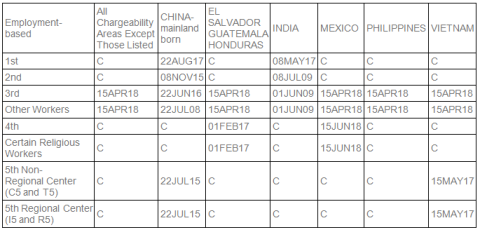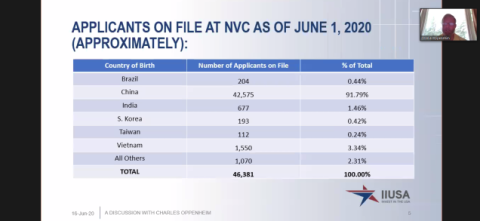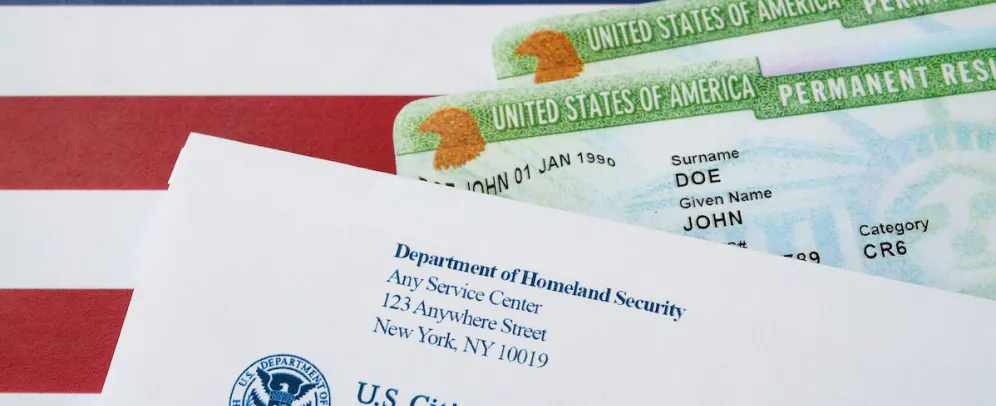Thursday, June 18, 2020 – The U.S. Department of State (DOS), Bureau of Consular Affairs, issued its monthly Visa Bulletin. During normal times, this bulletin summarizes the availability of visas, indicating when applicants are eligible and can submit required documentation to the National Visa Center as visas become available. Today, applicants filing D-S260 can still pay fees and become documentarily qualified, however, they face unprecedented delays when attempting to advance to the interview stage for visa issuance as consulates remain closed due to COVID-19. Charlie Oppenheim, Chief of the Visa Control and Reporting Division at the U.S. Department of State provided feedback to stakeholders at an IIUSA webinar shortly after the Visa Bulletin’s release. Bob Kraft, Chairman, and CEO of FirstPathway Partners is the President of IIUSA, the global EB-5 industry trade association, representing the majority of capital formation and job creation in the U.S. resulting from the EB-5 program.

Country Analysis
China
In July, China’s priority date advanced one week, after no advancement in June. With the Consulate in Guangzhou closed and no announced plans to reopen, only those with priority dates earlier than July 22, 2015, who are currently in the USA, eligible for adjustment of status, have an opportunity to obtain visas. It is uncertain how many Chinese adjustments are currently pending with U.S. Citizenship and Immigration Services (USCIS). DOS does not have visibility into China I-485 Adjustments pending on file at USCIS. DOS currently has a little over 3,000 China applications overall with July eligible priority dates for visas. It is unlikely Guangzhou could process that many, in the remaining months of FY20, even if they opened tomorrow. Oppenheim did however share positive news for China, indicating that this year is likely the last year visas will be offset from the Chinese Student Protection Act (CSPA) freeing up approximately 700 visas for fiscal years moving forward. EB-5 is expected to have no CSPA visa reduction impact in FY2021.
Vietnam
Vietnam advanced 23 days, consistent with last month.
India
In an anticipated move, India’s priority date is now current. This happened slightly earlier than projected. Oppenheim forecasted India to remain current for the remainder of FY 2020 and further is not expected to retrogress in the near future, as National Visa Center (NVC) only had 677 applicants on file as of June 1, 2020. In response to a question posed by Jennifer Sherer, Senior Vice President of FirstPathway Partners, Oppenheim indicated the wait has dropped significantly from his October 2019 estimate of 6.7 years but was not able to provide a new estimate at this time. This is great news for Indian petitioners. The other good news is India has already used about 500 of their 770 visas for FY20, so they do not stand to lose many visas this year if the consulate in Mumbai does not reopen.
Hong Kong
Hong Kong continues to be treated as a separate country and will stay as such baring legislative change.
Global Visa Use
So far Oppenheim estimates about 4,500 of the estimated 11,000 EB-5 visa numbers have been used in FY2020. In the event consulates do not reopen in 2020, potentially 6,500 EB-5 visas could go unused, minus the number of visas issued to those adjusting status here in the United States. This loss could be offset by the additional family numbers EB-5 stands to gain if family visas continue to go unused. DOS is conservatively anticipating 60,000 unused family numbers for FY2020, which could mean an additional 4,200 visas (7.1%) could go to EB-5 in FY2021.
Near Term Demand for Visas
Both NVC and USCIS are continuing to process cases. In addition, both are providing data to DOS monthly. There were approximately 46,381 applicants on file at NVC as of June 1, 2020. These numbers also represent some visa suppression, due to several months of consulate closures, leading to minimal visa usage. Surprisingly, 50% of eligible investors have not yet become documentarily qualified nor paid fee bills.
What happens if consulates do not reopen?
In response to a question asked by Jennifer Sherer, Senior Vice President of FirstPathway Partners, and later echoed by panelists, Oppenheim indicated that in the event consulates continue to remain closed in FY20, he was unlikely to move the priority dates to current or provide more rapid advancement allowing for more adjustments. He was open to possibly looking at this suggestion in FY21. Oppenheim feels in FY20 that there is still potential for numbers to be utilized at the posts. The primary recipient of these visas would be Chinese born, as with generally the oldest priority dates, they are entitled to the leftover visas from the rest of the world. He has plans to consult with the consulate in Guangzhou as the year progresses to see 1) if/when they will reopen and 2) if they could accommodate the large numbers of applicants for interviews.

